Archive
Library redesign

The essential redesign of the library must rethink the staff hierarchy and departmentalization which results in patron frustration. The library profession is all about empowering people to become information literate. In keeping with this vision, all staff should be empowered and knowledgeable enough to help patrons with the majority of their needs.
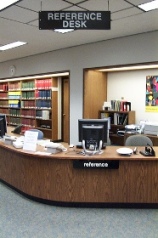
The reference desk attracts some but repels many. Its primary redeeming quality is that you can be confident of finding someone to help you there. Library staff are well-acquainted with patrons’ reluctance to approach the reference desk. Some people “don’t want to bother” the librarian. The formal nature of approaching a person behind a desk (often waiting your turn to do so) seems to require a question meriting consideration. Many people are afraid of looking stupid. Others don’t want to wait, or to go out of their way. The desk is a barrier, certainly, which makes libraries humiliatingly comparable to the DMV. Perhaps the worst characteristic of the desk is the picture staff present. Because staff behind the desk are generally concentrating on a computer screen while working on various projects they fail to exhibit “such welcoming behaviors as smiling, making eye contact, or saying hello” (Pitney, 2007). Behind a desk the reference librarian is, in a word, unapproachable.
Others don’t want to wait, or to go out of their way. The desk is a barrier, certainly, which makes libraries humiliatingly comparable to the DMV. Perhaps the worst characteristic of the desk is the picture staff present. Because staff behind the desk are generally concentrating on a computer screen while working on various projects they fail to exhibit “such welcoming behaviors as smiling, making eye contact, or saying hello” (Pitney, 2007). Behind a desk the reference librarian is, in a word, unapproachable.
Many libraries are taking steps to minimize or eliminate the reference desk and to increase roving. Take for instance the changes implemented by King County Library System. In response to patron feedback they changed the nature of the reference desk and introduced roving reference services.
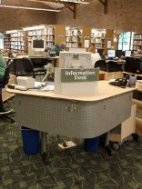
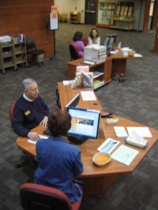
Goodbye reference fortress. Hello service points.
Like many libraries, KCLS is redesigning reference desks to make staff appear more approachable. In keeping with their mobile reference model, they’ve also changed the nomenclature from “reference desk” to “assistance point” or “service point.” This kidney shaped desk is ergonomically designed to raise and lower according to user needs.It can be adjusted to be used seated or standing. Pretty spiffy! And usable! The available work surface is minimized, so it really is a “service point” and not a desk for in-depth projects. Plus, its size makes it easy for staff to walk away from in order to rove.
The image to the right is a clever design which is increasing usability at the Sidney Silverman Library of Bergen Community College in Paramus, New Jersey. The stuctures are modular and moveable; their design is approachable from all sides. The real beauty here is the “butterfly computer” which features a dual monitor for a truly collaborative reference interaction. Far from abandoning the reference desk, by making it a shared space (with librarian and user on the same side of the desk), they have changed it from a barrier to a bridge.
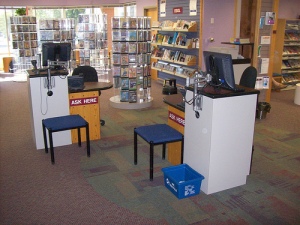 Columbus Metropolitan Library has redesigned the library for “proactive reference customer service.” Manager Christopher Korenowsky defines proactive reference as “a proactive, hands-on service model that gives individual attention to each customer. Our goal is to make floor-walking, proactive, high-touch service the minimal expectation as staff focuses on anticipating and responding to customer needs. Proactive reference creates an environment that empowers staff to provide ‘above-and-beyond service’ all day, every day.” The embodiment of the vision is this pared down, contemporary, customer focused reference station.
Columbus Metropolitan Library has redesigned the library for “proactive reference customer service.” Manager Christopher Korenowsky defines proactive reference as “a proactive, hands-on service model that gives individual attention to each customer. Our goal is to make floor-walking, proactive, high-touch service the minimal expectation as staff focuses on anticipating and responding to customer needs. Proactive reference creates an environment that empowers staff to provide ‘above-and-beyond service’ all day, every day.” The embodiment of the vision is this pared down, contemporary, customer focused reference station.
Integration of the librarian
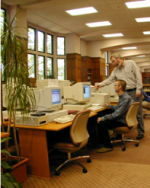 Librarians are taking a giant step forward by giving up the security of the desk. As Pitney and Slote acknowledge in the article Going Mobile which documents the changes at KCLS, “roving for most staff involved changing long-standing patterns of patron interaction. Traditionally, staff have comfortably sat behind a desk or counter and waited for patrons to come to them. Roving requires a different world view.”
Librarians are taking a giant step forward by giving up the security of the desk. As Pitney and Slote acknowledge in the article Going Mobile which documents the changes at KCLS, “roving for most staff involved changing long-standing patterns of patron interaction. Traditionally, staff have comfortably sat behind a desk or counter and waited for patrons to come to them. Roving requires a different world view.”
These efforts are moving in the right direction, but they don’t take it far enough. They are improving the manner in which services are offered, but are artificially limiting effectiveness by maintaining stringent staff roles by position and department. Librarians are redefining their own roles in relation to their patrons, but they must also change their attitudes about the roles of support staff and inter-departmental cooperation. Patrons will not be optimally served until all staff are willing and able to help them to the greatest extent possible.
Integration of technology tools
KCLS wisely installed stack-end OPAC units to support roving reference. (The new roving staff discovered quickly how inconveniently located their patron-use computers were to the point of need. Patrons had, no doubt, known this all along.) This is simple and elegant library design: the patrons can use the stack-end OPAC to serve themselves, library staff can collaboratively serve and educate patrons where the need arises. OPAC terminals should be plentiful in the stacks, in the children’s department, and near the circulation desk. In addition to catalog functions, all OPAC computers should have a library card self-registration module, for those patrons who prefer not to have to fill out a paper application form at the circulation desk.
 Columbus Metropolitan library has equipped its roving librarians with mobile, wearable communication devices. The communication badges allow staff to contact each other, as well as to make and receive phone calls. This, as much as anything, has truly freed them from the desk. The technology could also allow patrons at internet stations, stack-end OPACs or self-check machines to summon staff without having to leave their terminals.
Columbus Metropolitan library has equipped its roving librarians with mobile, wearable communication devices. The communication badges allow staff to contact each other, as well as to make and receive phone calls. This, as much as anything, has truly freed them from the desk. The technology could also allow patrons at internet stations, stack-end OPACs or self-check machines to summon staff without having to leave their terminals.
Integration of staff and staff functions
Just as every service point should be equipped to handle all patron needs, all staff should have the power, knowledge, and skills to assist patrons with all but the most complex inquiries. If a patron is trying to place a hold with a librarian but finds their account blocked by a problem with their library card or pin number, the librarian can resolve the problem themselves, without having to send the patron across the building to circulation and then back. By the same token, if a patron comes to the circulation desk to get a library card, the circulation worker should feel free to take that opportunity (if the patron wishes it) to teach the new patron how to use the OPAC, give them a quick tour of the library, or lead them to the collection they are interested in.
This redesigned library system would better serve patrons. It would, in fact, bring their library experience up to the already existing expectation that anyone, anywhere in the library, should be able to help with any query. OCLC survey respondents advised libraries to:
- • Have friendlier staff.
- • Increase the number of staff to help library users.
- • Hire more helpful and knowledgeable staff.
Patrons do not tend to differentiate between librarians and support staff, any more than they know whether they want to speak to someone in reference, circulation, outreach, or community relations. Patrons should be afforded a seamless experience even if they are entirely ignorant of the inner-workings of the library.
Staff, likewise, having received appropriate customer service and interdepartmental crosstraining, are likely to find their lives enriched along with their capacity to serve their patrons. The library administration and management, on the other hand, will encounter some headaches in enabling interdepartmental cooperation, more complex scheduling, and possibly re-classification of staff. I suspect these headaches, along with librarians who jealously guard their domain, explain why libraries have presently (to my knowledge) failed to make this obvious enhancement.
Barbara Pitney and Nancy Slote’s article Going mobile: the KCLS roving reference model, appears in Public Libraries. Chicago: Jan/Feb 2007. Vol. 46, Iss. 1; p. 54
Doing dewey
There are lots of ways to classify things. In the children’s department I have often discovered young patrons making the library look tidier by neatly grouping books of the same height. I once discovered an adult patron sorting books by color. Bookstores have devised various means of loosely associating books into sections such as “travel” and “art and architecture.”
We’re all familiar with items that defy easy classification. The strength of the Dewey Decimal System is that a librarian or savvy patron can identify, with the help of the catalog, exactly where any given item will be found on the shelf. The strength of the bookstore model is in browsing. While it may not be easy to find a particular item, the customer is likely to easily find many items of interest. Shonda Brisco, in her article Dewey or Dalton?, similarly concludes that bookstores are not organized to optimize the ability of the customer to find a particular book.
At our library, users love to browse the on-line catalog. They place items of interest on hold, we collect them and organize them by patron name, ready to be picked up. From my perspective, this is where libraries are going. In order for this system to work it is imperative that we know precisely where each item is to be found. To me it is just silly to talk about doing away with Dewey. Goofy. Short-sighted. Fickle. Capricious. Anathema to the whole idea of the library. Though it’s hard to argue with success as sited by Victoria’s Bayside Library in the article Decimating Dewey (Hopkins, S, 2007), a cataloging curmudgeon might suggest that the increase in usage was due to the excitement generated by change, and not the nature of the change itself. I predict that they will become disenchanted with the fragmentation of their collection, with its reliance on spine-obscuring stickers, and wish to re-unify the collection within the next few years.
What I do support is a browsing collection for the many patrons who come to the library without a title or subject in mind. Many libraries do this informally with a table of “hot reads” or a display on a featured topic. I like the idea of expanding this to a larger collection of popular items for casual users who do not wish to embrace the catalog or master the classification system. People who just want something to read or watch could easily find it here. The popular collection could be uncatalogued or minimally catalogued and not available for reserve. King library in San Jose has established such a collection.
Library as third space
Kuntsler is right on with his concerns. I agree so strongly that I’m afraid I have a tendency to become unpleasantly self-righteous and strident on these subjects. I live downtown, just a few blocks from where I work. People often tell me how lucky I am not to have to make a long expensive car commute, but the truth is that luck has nothing to do with it. I purposely set up my life that way, and my family lived without a car (and other things that many in America consider “necessities”) for many years in order to afford the mortgage payment. (You see what I mean about the self-righteousness?)
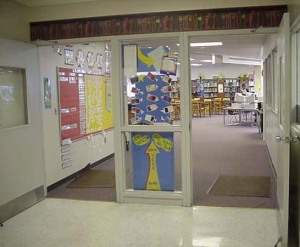
 And, yes, I think our civic architecture informs us of who we are and where we’re going. I think our buildings effect our behavior, our level of optimism, even our thought processes. I went to junior high in a building designed like a jail. The students and staff behaved as though that’s what it was. There was no reaching for the stars. We were just trying to get through the day without a major incident or detention. On the left is a photo of the library at my junior high. On the right is, of course, UW’s own Suzzallo library’s reading room. In which room would you be more likely to excel? To define yourself as a worthy citizen of a great country?
And, yes, I think our civic architecture informs us of who we are and where we’re going. I think our buildings effect our behavior, our level of optimism, even our thought processes. I went to junior high in a building designed like a jail. The students and staff behaved as though that’s what it was. There was no reaching for the stars. We were just trying to get through the day without a major incident or detention. On the left is a photo of the library at my junior high. On the right is, of course, UW’s own Suzzallo library’s reading room. In which room would you be more likely to excel? To define yourself as a worthy citizen of a great country?
I think the function of library as third space, meeting space, social space, and leisure space is integral to its modern role and of utmost importance to our communities. Of all the possible ways to encourage this usage and to make the library a pleasant space to inhabit, the addition of food and drink is the one I like the least. Possibly this comes from my daily work experience with damaged library returns. Maybe I hate to see the role of library staff further degraded to busboy, waitress, janitor. Perhaps it bothers me to see the little library cafe in competition with adjacent local businesses whose expertise is with coffee and food, and who are dependent for livelihood on the ability to sell them. Regardless, I see I’m bucking the trend. It’s 2008 and libraries must sell coffee and food and deal with the consequences throughout the building.
Actually, I’m exaggerating my opposition somewhat. Our library has been allowing beverages explicitly and food tacitly for some time now and there haven’t been too many problems. And I do support the idea that libraries should not start from the assumption that people don’t know how to behave responsibly. My junior high lesson, that people will rise or fall to expectations has been demonstrated again and again!
Doing dewey
There are lots of ways to classify things. In the children’s department I have often discovered young patrons making the library look tidier by neatly grouping books of the same height. I once discovered an adult patron sorting books by color. Bookstores have devised various means of loosely associating books into sections such as “travel” and “art and architecture.”
We’re all familiar with items that defy easy classification. The strength of the Dewey Decimal System is that a librarian or savvy patron can identify, with the help of the catalog, exactly where any given item will be found on the shelf. The strength of the bookstore model is in browsing. While it may not be easy to find a particular item, the customer is likely to easily find many items of interest. Shonda Brisco, in her article Dewey or Dalton?, similarly concludes that bookstores are not organized to optimize the ability of the customer to find a particular book.
At our library, users love to browse the on-line catalog. They place items of interest on hold, we collect them and organize them by patron name, ready to be picked up. From my perspective, this is where libraries are going. In order for this system to work it is imperative that we know precisely where each item is to be found. To me it is just silly to talk about doing away with Dewey. Goofy. Short-sighted. Fickle. Capricious. Anathema to the whole idea of the library. Though it’s hard to argue with success as sited by Victoria’s Bayside Library in the article Decimating Dewey (Hopkins, S, 2007), a cataloging curmudgeon might suggest that the increase in usage was due to the excitement generated by change, and not the nature of the change itself. I predict that they will become disenchanted with the fragmentation of their collection, with its reliance on spine-obscuring stickers, and wish to re-unify the collection within the next few years.
What I do support is a browsing collection for the many patrons who come to the library without a title or subject in mind. Many libraries do this informally with a table of “hot reads” or a display on a featured topic. I like the idea of expanding this to a larger collection of popular items for casual users who do not wish to embrace the catalog or master the classification system. People who just want something to read or watch could easily find it here. The popular collection could be uncatalogued or minimally catalogued and not available for reserve. King library in San Jose has established such a collection.
Design principles
I like the Robin Williams book, and think her concepts are useful. I’m struck, though, with the idea that our ideas of what constitutes good design might have as much to do with fashion as usability. Center alignment, for instance, just isn’t in fashion now. Some of my classmates found websites that featured center-aligned lists of links (blue, with underlines) that looked very old-fashioned and amateurish–but really that design is simple and easy-to-use. Our dislike of it is based on an emotional reaction which favors modernity (until something is out of fashion enough to be “retro”).
Today I saw an interesting new app: Poladroid, which (you guessed it) allows you to make your perfect digital images look like crappy old polariods. Part of me is appalled, while the other part thinks it’s really neat-o!
Usability testing
In keeping with my rabid hatred for Millennium and other equally Integrated Library Systems which shackle us to their will, I am interested in open source systems. Therefore, I conducted usability tests on a library using Evergreen’s open source software, Whistler Public Library.
I had my users search for the same book I used for my OPAC comparison, “Omnivore’s Dilemma.” Both subjects easily found and used the exceedingly simple search box. My teenager had trouble spelling “dilemma” but the search engine provided him with the result as a “maybe you meant.”
There weren’t a lot of bells and whistles. I asked my users to find a related book they’d be interested in. The young’un chose the “relevant subject” heading “food preferences” from which he spent a few annoyed minutes in the unfortunately named “cookery.” He was flummoxed by the subsequent “relevant subjects” of “brothers and sisters” and “freres et soeurs,” as am I. After a while he hit the back button a few times, chose the “relevant subject” heading “food habits” and settled on Slow food: the case for taste. There he noticed the understated “Actions–>browse” link, which he found much easier to use.
My other subject outsmarted me by just typing in “Fast Food Nation” in the search box. When I asked him to consider the possibility he might want to explore a subject without having a title in mind he insisted that he never would. (!)
I linked to Whistler’s catalog from the Evergreen site, but when I wanted my subjects to look at the homepage there seemed to be no such animal. A google search found no usable links. The BC libraries directory link was also broken. Is there only a catalog now? We were unable to find library hours, location, or events through the site. Also disturbing to me was the site title “Evergreen Titles” which breaks Klug’s law of usability regarding ease of identifying the site. I would be unable to identify it by the tab in Firefox.
Great analysis, Julie! I hadn’t thought about the difference between bookstores who want you to pick up lots of books and libraries who want you to find exactly the right book (in a nutshell). Thanks for the different perspective.
Apparently, back before Dewey came up with his system, book size was one way that libraries routinely organized books, with fixed shelf locations!
You make a great point about the hold system and needing a fixed address for each item to make it work. They’re doing a lot of that at my local library these days. It’s another case (like the database behind the OPAC) where people who use the library couldn’t care less how it’s actually organized, as long as they get their stuff.